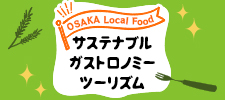Sakai food culture

Knife
Knives are indispensable for cooking. Sakai was said to be the birthplace of everything, and the manufacture of guns and textiles was also one of the earliest places to begin in Sakai, but the development of Sakai knives dates back to the Toyotomi period through to the early Tokugawa period. Knives used to shave kelp into oboro konbu require a process called "akita" where the blade tip is bent before shaving, and to do this, a knife that combines a sharp cutting edge with flexibility that allows it to cling to the kelp is required. It can be said that the 600-year-old craftsmanship of Sakai knives has made it possible to meet this difficult requirement. The Sakai Cutlery Museum is located at the Sakai Traditional Industry Hall, and the craftsmanship of Sakai forged knives lives on in knife factories all over Sakai city.

tea ceremony
The tea ceremony, or chanoyu, in which tea is made using matcha and served to guests, is one of Japan's proud arts. Matcha, which was brought to Japan by Eisai during the Kamakura period, began to spread mainly in Zen temples, and the know-how of tea plant cultivation and steaming methods also spread. During the Nanboku-cho period, tea contests, in which participants tried to guess which tea was from each region, spread among the samurai class. In response to this entertainment-oriented style of tea, the style of wabicha emerged, influenced by Zen thought and idealizing a life away from the secular world. First, Murata Juko created the origins of wabicha, which aims for "tea and Zen in harmony," incorporating simple Japanese tea utensils such as Shigaraki and Iga into tea utensils, which had previously been centered on Chinese items. This idea was accepted and spread by the merchants of Sakai, who had gained great wealth through international trade. Among these Sakai townspeople were Takeno Jo'o and his disciple Sen no Rikyu. Rikyu perfected wabi-cha, which became popular among the samurai class and eventually led to the modern tea ceremony. As a city where the culture of tea ceremony developed, Sakai also became a popular place for making sweets to accompany tea, and Japanese confectionery shops with over 400 years of history are still in business today. Sakai City also currently has an ordinance in place to promote the "spirit of hospitality" through the tea ceremony.
 *Image of Sen no Rikyu (Sakai City Museum Collection)
*Image of Sen no Rikyu (Sakai City Museum Collection)
Sen no Rikyu
Sen no Rikyu, a tea master of the Azuchi-Momoyama period, is known as the perfector of wabi-cha tea and the "tea saint." His family was a merchant who operated a warehouse that stored imported goods at the port of Sakai. At the age of 19, he began studying under Takeno Joo, and dedicated 51 years to the way of tea until his untimely death at the age of 70. He served as the head tea master for powerful men of the time, such as Oda Nobunaga and Toyotomi Hideyoshi, and was praised as the greatest tea master in the world. Rikyu preached an ascetic way of tea ceremony that eliminated waste, saying, "There is no need for expensive things or famous items," and created a smaller tea room than before, the "sōan tea room," and established the spiritual world of "ichigo ichie," and tea ceremony as a comprehensive art. His name has left a significant mark not only on the tea ceremony but also on Japanese traditions, such as the shape of the chopsticks known as "Rikyu chopsticks," the color "Rikyu gray," and the cooking method known as "Rikyu yaki." The "sōan tea room" also had a major impact on Japanese architecture. The style of tea ceremony he perfected, known as "wabicha," has been passed down to subsequent tea ceremonies, and his descendants continue it as the Sansen school of tea ceremony.
-
 Sakai Knives Museum
Sakai Knives MuseumThis facility introduces the appeal of Sakai knives through displays and videos. In addition to a permanent exhibition that shows the manufacturing process and types of Sakai knives, which are used in a variety of fields including kitchen knives, iron, and tools, there is also a sales corner with a wide variety of knives, from professional to Western-style for home use.
-
 Sakai Toshiaki no Mori (Chanoyu experience (Ryurei tea ceremony))
Sakai Toshiaki no Mori (Chanoyu experience (Ryurei tea ceremony))Learn compassion through the tea ceremony
-
 Creating “tradition and history are great!”
Creating “tradition and history are great!”"Umami" has now become an international word. ``Dashi'', which can be said to be the origin of the word, is the basis of Japanese food culture and is unique to Japan. This “da…
-
 ~Seafood/Yamasai~Naniwa Terroir
~Seafood/Yamasai~Naniwa TerroirOsaka Bay was once so rich in fish that it was called the Fish Garden. It is written as ``fish garden'' and is pronounced as ``naniwa''. That is Naniwa, another name for Osaka...


